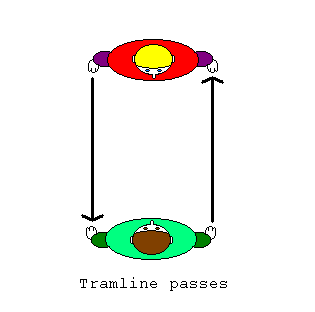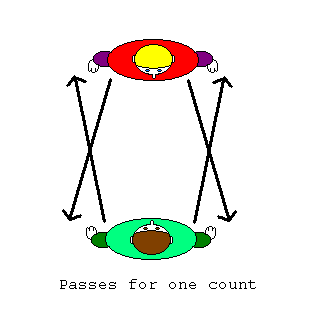Next Contents
Home
Basics
In passing, every now and then you throw things at other jugglers. Also
other jugglers throw things at you. Ideally the other jugglers catch whatever
you throw at them and vice-versa. To help this happen the jugglers usually
agree on a regular rhythm to pass to.
To describe these rhythms, or counts,
let's consider two jugglers passing together. They stand facing each other
and start with three objects each (usually clubs, but rings or balls are ok).
For most of the basic patterns, they start with a pass and
always pass at the same time. Each juggler's right
hand passes are caught by his partner in the left hand. Similarly left hand passes
are caught in the right hand. These passes are tramline
passes.

Four count
Most people start by learning four count, so just about everyone who
passes will know this count. It's called four count because every fourth
throw is a pass to your partner. You both start with two clubs in your
right hand and one in your left. The first throw is a right hand tramline
pass to your partner. The next three throws are selfs. A self is a normal throw of a three club
cascade. The pattern continues pass, self, self, self, pass, self, self, self,.....
All the passes are right hand passes and every other right hand throw
is a pass. This gives rise to another name for four count, which is 'every
others'.
Two count
In two count every second throw is a pass to your partner. You both start
with two clubs in your right hand and one in your left. The first throw
is a right hand tramline pass to your partner. The next throw is a self.
The pattern continues pass, self, pass, self,.... Every right hand throw
is a pass. This gives rise to another name for two count, which is 'solids'.
Two count is also known as 'the shower'.
Three count
In three count every third throw is a pass to your partner. You both start
with two clubs in your right hand and one in your left. The first throw
is a right hand tramline pass to your partner. The next two throws are
selfs. The next throw is a left hand pass! This is followed by two selfs.
The pattern continues pass, self, self, pass, self, self,.... Three count is
also known as 'waltzing', partly because its rhythm is the same as the
waltz, and partly because you often end up swaying from side to side as
you juggle three count.
One count
In one count every throw is a tramline pass to your partner. Do I need
to say more? To avoid collisions the passes should be made from the centre
of your body to just outside your partners hands. See the diagram below:
 One count is also known as 'ultimates' and 'thunder shower'.
One count is also known as 'ultimates' and 'thunder shower'.
Pass, pass, self
Pass, pass, self is a fairly self explanatory pattern. The passes should
be made in the same way as those for one count to avoid collisions. You
pass two out of every three clubs. Because of this some people call it
2/3 count. Pass, pass, self is also known as 'ogilvys'.
Ins and outs
In patterns with more than two jugglers you can pass to one juggler and
receive a pass from another juggler at the same time. For example with
three jugglers, A, B and C, A can pass to B, B can pass to C and C can
pass to A. Passes like this are known as ins or outs. If you pass with
your right hand to a juggler on your right, and receive with your left
hand from a juggler on your left, you are passing outs. If you pass with
your right hand to a juggler on your left, and receive with your left hand
from a juggler on your right, you are passing ins. |

